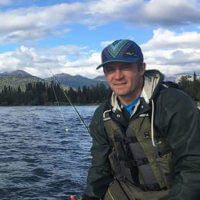University of Virginia, B.Sc. Mechanical Engineering
Homer, AK, is about 4,500 road miles from my natal stream of Baton Rouge, LA, and an average delta T of over 40 deg. Although I haven’t quite acclimated to the winters, even after 10 years in the Last Frontier, my pursuit of wild places was birthed during my college years at the University of Virginia on trails of the Appalachian. A path that began on Springer Mountain, somehow eventually meandered its way to the southern tip of the Kenai Peninsula. A summer job in fisheries served as an excuse to spend the field season outside and handle some wild critters. After nine field seasons, countless salmonids, and many miles logged dragging heavy freighter canoes alongside Dr. Harris, I was afforded the opportunity to join the ‘A Team’ at APU’s FAST lab.
My Project
Within Cook Inlet, the Pacific razor clam has been monitored in varying capacities since 1965, shortly after roads made the fishery gradually more accessible there in the late 1950s. Populations sustaining harvest have existed between Kasilof and Anchor Point, with the majority of the effort reliably occurring on Ninilchik and Clam Gulch beaches. Since 1985, specimens have been taken from various locations along these beaches for age and length measurements. It was noted by multiple researchers over the years that specific sub-populations tended to have different growth rates. Owing to the sedentary nature of razor clams, growth rates can potentially change over small spatial scales due to the heterogeneity of localized environments. Understanding the underlying factors influencing growth variation along Cook Inlet is essential, especially when considering their role in harvest, maturity, reproduction, mortality, and overall population dynamics. The aim of this research is to characterize the influence environmental parameters have on the growth rate of the Pacific razor clam along the eastern side of Cook Inlet. The environmental parameters monitored will include the following: temperature, dissolved oxygen, salinity, nitrate and phosphate concentration, substrate composition, chlorophyll a, and current trends.
Funding for this work is provided by the Pollock Conservation Cooperative via the Alaska Education Tax Credit Program.
Partners:
Alaska Department of Fish & Game (ADF&G)
Publications:
Kerkvliet, C. M., M. D. Booz, B. J. Failor, and T. Blackmon. In prep. Sport fisheries in the Lower Cook Inlet management area, 2014-2016, with updates for 2013. Alaska Department of Fish and Game, Fishery Management Report, Anchorage.

